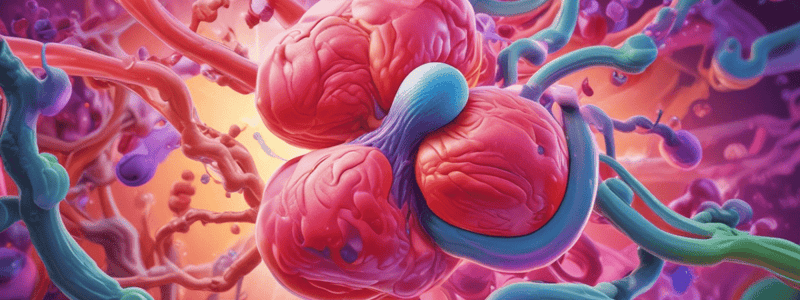Podcast
Questions and Answers
Which one of the following is the primary elimination route for many medications?
Which one of the following is the primary elimination route for many medications?
- Tubular reabsorption
- Tubular secretion
- Passive diffusion
- Glomerular filtration (correct)
What process is usually responsible for the active secretion of drugs into the urine?
What process is usually responsible for the active secretion of drugs into the urine?
- Passive diffusion
- Tubular reabsorption
- Glomerular filtration
- Tubular secretion (correct)
What is the main factor that influences the process of tubular reabsorption?
What is the main factor that influences the process of tubular reabsorption?
- Lipid solubility and degree of molecular ionization (correct)
- Glomerular filtration rate
- Tubular secretion rate
- Molecular size
How does the glomerular filtration rate (GFR) typically change as humans age?
How does the glomerular filtration rate (GFR) typically change as humans age?
Which of the following statements about tubular secretion is correct?
Which of the following statements about tubular secretion is correct?
What is the primary factor that determines the extent of tubular reabsorption?
What is the primary factor that determines the extent of tubular reabsorption?
Which of the following equations describes the various routes of renal elimination?
Which of the following equations describes the various routes of renal elimination?
What is the typical range of glomerular filtration rate (GFR) in young, healthy adults between the ages of 18-22 years?
What is the typical range of glomerular filtration rate (GFR) in young, healthy adults between the ages of 18-22 years?
What is the expected glomerular filtration rate for otherwise healthy, normal 80-year-old adults?
What is the expected glomerular filtration rate for otherwise healthy, normal 80-year-old adults?
In patients with renal disease, what leads to the functional loss of nephrons?
In patients with renal disease, what leads to the functional loss of nephrons?
What is the usual normal range for glomerular filtration rate according to most clinical laboratories?
What is the usual normal range for glomerular filtration rate according to most clinical laboratories?
In acute renal failure, which of the following can lead to a sudden decrease in renal blood flow?
In acute renal failure, which of the following can lead to a sudden decrease in renal blood flow?
What is the formula for calculating creatinine clearance rates as per the text?
What is the formula for calculating creatinine clearance rates as per the text?
Which type of patients are more likely to recover their kidney function to pre-insult level post-acute renal failure?
Which type of patients are more likely to recover their kidney function to pre-insult level post-acute renal failure?
What happens to patients with chronic renal failure according to the text?
What happens to patients with chronic renal failure according to the text?
How can creatinine clearance rates be measured according to the text?
How can creatinine clearance rates be measured according to the text?
What is the body surface area used for normalizing estimated creatinine clearance?
What is the body surface area used for normalizing estimated creatinine clearance?
In a patient with renal dysfunction, what can be done to achieve a concentration/time profile similar to that seen in a normal patient receiving the normal dose?
In a patient with renal dysfunction, what can be done to achieve a concentration/time profile similar to that seen in a normal patient receiving the normal dose?
What is the total daily dose for patients with renal disease receiving a dosage regimen of 150 mg every 6 hours?
What is the total daily dose for patients with renal disease receiving a dosage regimen of 150 mg every 6 hours?
For liver-metabolized drugs in patients with hepatic dysfunction, what dosing options are usually available?
For liver-metabolized drugs in patients with hepatic dysfunction, what dosing options are usually available?
What effect does giving a smaller dose of a drug at the same dosage interval usually have on the concentration/time profile?
What effect does giving a smaller dose of a drug at the same dosage interval usually have on the concentration/time profile?
What happens to the concentration/time profile when giving the same dose but prolonging the dosage interval in a patient with renal disease?
What happens to the concentration/time profile when giving the same dose but prolonging the dosage interval in a patient with renal disease?
What is the average steady-state concentration like when comparing renal disease dosage regimens?
What is the average steady-state concentration like when comparing renal disease dosage regimens?
What type of drug metabolism reactions are often mediated by the cytochrome P-450 enzyme system (CYP)?
What type of drug metabolism reactions are often mediated by the cytochrome P-450 enzyme system (CYP)?
Where is the cytochrome P-450 enzyme system (CYP) bound?
Where is the cytochrome P-450 enzyme system (CYP) bound?
What type of enzymes may mediate Phase II drug metabolism reactions in the liver?
What type of enzymes may mediate Phase II drug metabolism reactions in the liver?
What is the general effect of Phase I and Phase II drug metabolism on the metabolites?
What is the general effect of Phase I and Phase II drug metabolism on the metabolites?
What is the primary function of transport proteins, such as P-glycoprotein, in the liver?
What is the primary function of transport proteins, such as P-glycoprotein, in the liver?
What is the primary characteristic of hepatitis in patients?
What is the primary characteristic of hepatitis in patients?
How does acute hepatitis affect drug metabolism in patients?
How does acute hepatitis affect drug metabolism in patients?
What is the primary characteristic of hepatic cirrhosis in patients?
What is the primary characteristic of hepatic cirrhosis in patients?
What is the Child-Pugh score range that indicates a moderate decrease (approximately 25%) in initial daily drug dose for agents primarily metabolized by the liver?
What is the Child-Pugh score range that indicates a moderate decrease (approximately 25%) in initial daily drug dose for agents primarily metabolized by the liver?
If a drug is 95% liver metabolized with a usual dose of 500 mg every 6 hours, what would be an appropriate initial dose for a hepatic cirrhosis patient with a Child-Pugh score of 12?
If a drug is 95% liver metabolized with a usual dose of 500 mg every 6 hours, what would be an appropriate initial dose for a hepatic cirrhosis patient with a Child-Pugh score of 12?
What is the Child-Pugh score range that indicates a significant decrease (approximately 50%) in initial daily dose for drugs that are mostly liver metabolized?
What is the Child-Pugh score range that indicates a significant decrease (approximately 50%) in initial daily dose for drugs that are mostly liver metabolized?
If a patient has normal liver function, what is their Child-Pugh score?
If a patient has normal liver function, what is their Child-Pugh score?
What is the Child-Pugh score for a patient with grossly abnormal serum albumin, total bilirubin, prothrombin time values, severe ascites, and hepatic encephalopathy?
What is the Child-Pugh score for a patient with grossly abnormal serum albumin, total bilirubin, prothrombin time values, severe ascites, and hepatic encephalopathy?
If a drug is primarily metabolized by the liver, what percentage of the initial daily dose would be appropriate for a patient with a Child-Pugh score of 8?
If a drug is primarily metabolized by the liver, what percentage of the initial daily dose would be appropriate for a patient with a Child-Pugh score of 8?
According to the information provided, which of the following statements is true?
According to the information provided, which of the following statements is true?
What is the total daily dose of a medication that is 95% liver metabolized with a usual dose of 500 mg every 6 hours?
What is the total daily dose of a medication that is 95% liver metabolized with a usual dose of 500 mg every 6 hours?
Flashcards are hidden until you start studying
Study Notes
Renal Elimination
- The primary elimination route for many medications is through the kidneys.
- Active secretion of drugs into the urine is usually responsible for tubular secretion.
- The main factor that influences tubular reabsorption is the lipid solubility of the drug.
- The glomerular filtration rate (GFR) typically decreases with age.
Glomerular Filtration Rate (GFR)
- The typical range of GFR in young, healthy adults is 95-145 mL/min.
- The expected GFR for otherwise healthy, normal 80-year-old adults is 60-80 mL/min.
- In patients with renal disease, the functional loss of nephrons leads to a decrease in GFR.
- The usual normal range for GFR according to most clinical laboratories is 90-120 mL/min.
Renal Disease
- Acute renal failure can lead to a sudden decrease in renal blood flow due to various factors.
- In chronic renal failure, there is a gradual decline in kidney function over time.
- Creatinine clearance rates can be measured using the formula: CrCl = (U x V) / (P x 1440).
Dosing Adjustments
- In patients with renal disease, giving a smaller dose of a drug at the same dosage interval leads to a lower concentration/time profile.
- Giving the same dose but prolonging the dosage interval in a patient with renal disease leads to a lower peak concentration and a longer elimination half-life.
- The average steady-state concentration in renal disease dosage regimens is lower than in normal patients.
- For liver-metabolized drugs in patients with hepatic dysfunction, dosing options include reducing the dose or increasing the dosage interval.
Hepatic Metabolism
- The cytochrome P-450 enzyme system (CYP) is bound to the endoplasmic reticulum in the liver.
- Cytochrome P-450 enzyme system (CYP) mediates Phase I drug metabolism reactions in the liver.
- Phase II drug metabolism reactions in the liver are often mediated by enzymes such as glucuronidases and sulfotransferases.
- The general effect of Phase I and Phase II drug metabolism on the metabolites is to increase their water solubility and facilitate excretion.
Hepatitis and Cirrhosis
- The primary characteristic of hepatitis in patients is inflammation of the liver.
- Acute hepatitis affects drug metabolism in patients by reducing the activity of hepatic enzymes.
- The primary characteristic of hepatic cirrhosis in patients is scarring of the liver.
- The Child-Pugh score indicates the severity of liver dysfunction, with higher scores indicating greater impairment.
Child-Pugh Score
- A Child-Pugh score of 5-6 indicates normal liver function.
- A Child-Pugh score of 7-9 indicates moderate liver dysfunction, and a score of 10-15 indicates severe liver dysfunction.
- For drugs primarily metabolized by the liver, the initial daily dose is reduced by approximately 25% for patients with a Child-Pugh score of 7-9, and by approximately 50% for patients with a score of 10-15.
Studying That Suits You
Use AI to generate personalized quizzes and flashcards to suit your learning preferences.




